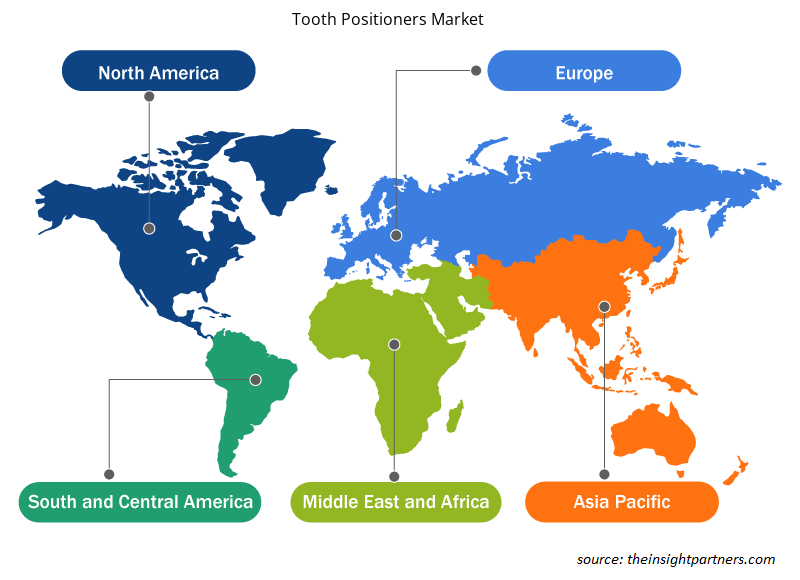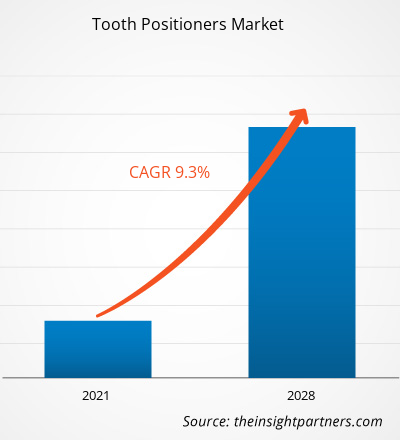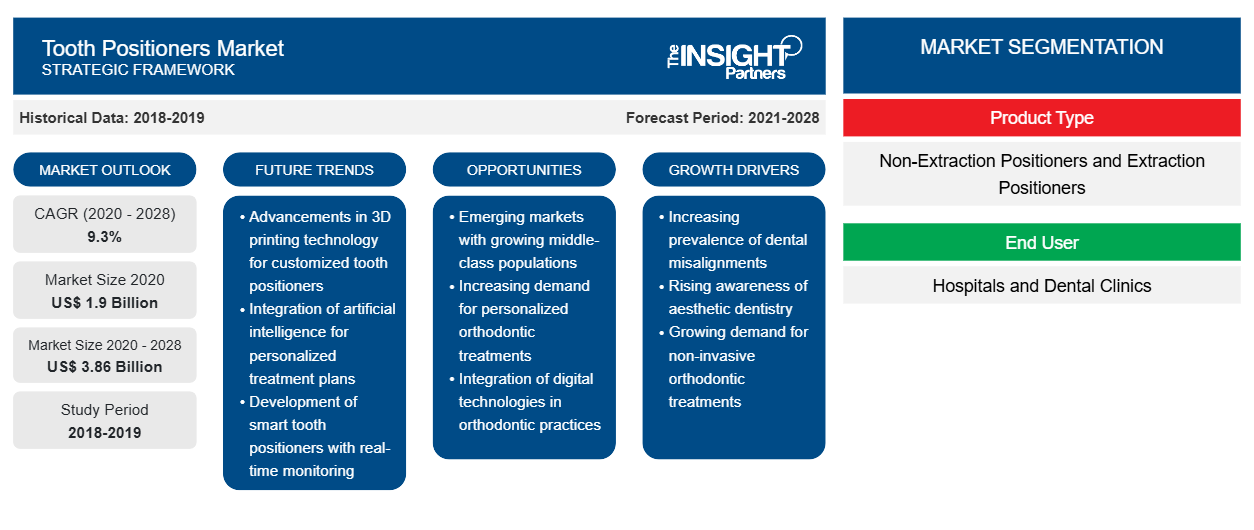Il mercato dei posizionatori dentali è stato valutato a 1.901,91 milioni di dollari nel 2020 e si prevede che raggiungerà i 3.855,65 milioni di dollari entro il 2028; si prevede una crescita a un CAGR del 9,3% nel periodo 2021-2028.
I posizionatori dentali sono noti apparecchi ortodontici formati da un corpo a forma di arco di un materiale resiliente (Silastic); si adattano perfettamente alla bocca del paziente tra l'arcata superiore e quella inferiore. Sono utilizzati per controllare l'assestamento dentale e per ridurre al minimo o eliminare la recidiva dei denti dopo un trattamento ortodontico.
La crescente prevalenza di problemi dentali spinge all'adozione di sistemi di posizionamento dei denti. Le malattie dentali e orali colpiscono le persone almeno una volta nella vita. Il semplice mal di denti può causare dolore insopportabile, disagio e deturpazione. Secondo il rapporto dell'American Dental Association pubblicato nel 2019, il 50,4% dei bambini con Medicaid o CHIP e il 67,1% dei bambini con assicurazione privata hanno avuto visite dal dentista nel 2016. La malattia parodontale, che provoca la perdita dei denti, è all'11° posto tra le malattie dentali più diffuse al mondo. La prevalenza di condizioni dentali e orali come morsi profondi, denti storti, morsi inversi, morsi incrociati, spazi tra i denti, affollamento dei denti e disturbi temporomandibolari (TMD) è in aumento in tutto il mondo. I principali fattori che portano a problemi dentali includono lesioni, malattie parodontali, incidenti e altri. Secondo i dati della Canadian Association of Orthodontists, circa 4 milioni di persone in Canada e negli Stati Uniti stanno ricevendo cure da uno specialista ortodontico. Inoltre, secondo i dati dei Centers for Disease Control and Prevention (CDC), circa il 31,6% della popolazione degli Stati Uniti ha avuto carie dentali non trattate nel periodo 2013-2016. Inoltre, secondo un rapporto di indagine pubblicato nel 2018, il 62% dei soggetti si è recato dal dentista almeno una volta nel 2016 e, mentre il 62% di loro ha avuto almeno una visita dal dentista nel 2017, il 52% ha preso l'appuntamento più recente per un controllo regolare. Pertanto, la crescente prevalenza di problemi dentali guida la crescita del mercato dei posizionatori dentali
Personalizza questo report in base alle tue esigenze
Riceverai la personalizzazione gratuita di qualsiasi report, comprese parti di questo report, o analisi a livello nazionale, pacchetto dati Excel, oltre a usufruire di grandi offerte e sconti per start-up e università
-
Scopri le principali tendenze di mercato in questo rapporto.Questo campione GRATUITO includerà analisi di dati che spaziano dalle tendenze di mercato alle stime e alle previsioni.
Approfondimenti di mercato
La medicina odontoiatrica estetica è una delle procedure cosmetiche più comuni al mondo. L'American Academy of Dentistry (AACD) è la risorsa principale per i pazienti che vogliono mantenere il loro benessere, le loro prestazioni lavorative e il loro aspetto. In linea con l'American Society for Cosmetic Surgery (ASPS), l'odontoiatria ha registrato un recente boom con un aumento del 47% delle procedure richieste dalle persone di età compresa tra 51-64 e 64 anni. I costi della cosmetica dentale sono inferiori nei paesi nordamericani. Le procedure tipiche dei dentisti estetici e le procedure principali dei dentisti estetici nei paesi nordamericani hanno una differenza di costo di circa 50-150 $ USA per corona o faccetta. I dentisti in Messico hanno laboratori di alta qualità e forniscono corone economiche.
Prodotti: Approfondimenti tecnologici
Il mercato globale dei posizionatori dentali, in base al tipo di prodotto, è diviso in posizionatori non estrattivi e posizionatori estrattivi. Il segmento dei posizionatori non estrattivi ha detenuto una quota maggiore del mercato nel 2020. Tuttavia, si prevede che lo stesso segmento registrerà un CAGR più elevato nel mercato durante il periodo di previsione.
Utente finale:
In base all'utente finale, il mercato globale dei posizionatori dentali è segmentato in ospedali e cliniche odontoiatriche. Il segmento degli ospedali ha detenuto la quota maggiore del mercato nel 2020 e si prevede che il segmento delle cliniche odontoiatriche registrerà il CAGR più elevato nel periodo 2021-2028.
Gli operatori che operano nel mercato dei posizionatori dentali adottano strategie di collaborazione e partnership per soddisfare le esigenze degli utenti finali attraverso l'introduzione di offerte tecnologicamente avanzate; queste strategie supportano in modo significativo la crescita del mercato.
Approfondimenti regionali sul mercato dei posizionatori dentali
Le tendenze regionali e i fattori che influenzano il mercato dei posizionatori dentali durante il periodo di previsione sono stati ampiamente spiegati dagli analisti di Insight Partners. Questa sezione discute anche i segmenti e la geografia del mercato dei posizionatori dentali in Nord America, Europa, Asia Pacifico, Medio Oriente e Africa e Sud e Centro America.

- Ottieni i dati specifici regionali per il mercato dei posizionatori dei denti
Ambito del rapporto di mercato sui posizionatori dei denti
| Attributo del report | Dettagli |
|---|---|
| Dimensioni del mercato nel 2020 | 1,9 miliardi di dollari USA |
| Dimensioni del mercato entro il 2028 | 3,86 miliardi di dollari USA |
| CAGR globale (2020 - 2028) | 9,3% |
| Dati storici | 2018-2019 |
| Periodo di previsione | 2021-2028 |
| Segmenti coperti |
Per tipo di prodotto
|
| Regioni e Paesi coperti |
America del Nord
|
| Leader di mercato e profili aziendali chiave |
|
Densità dei player del mercato dei posizionatori dentali: comprendere il suo impatto sulle dinamiche aziendali
Il mercato dei posizionatori dentali sta crescendo rapidamente, spinto dalla crescente domanda degli utenti finali dovuta a fattori quali l'evoluzione delle preferenze dei consumatori, i progressi tecnologici e una maggiore consapevolezza dei vantaggi del prodotto. Con l'aumento della domanda, le aziende stanno ampliando le loro offerte, innovando per soddisfare le esigenze dei consumatori e capitalizzando sulle tendenze emergenti, il che alimenta ulteriormente la crescita del mercato.
La densità degli operatori di mercato si riferisce alla distribuzione di aziende o società che operano in un particolare mercato o settore. Indica quanti concorrenti (operatori di mercato) sono presenti in un dato spazio di mercato in relazione alle sue dimensioni o al valore di mercato totale.
Le principali aziende che operano nel mercato dei posizionatori dentali sono:
- Ortodonzia TP, Inc.
- Allineare l'ortodonzia
- Laboratorio ortodontico Dockstader, Inc.
- DENTAURUM GmbH & Co. KG
- 3 milioni
Disclaimer : le aziende elencate sopra non sono classificate secondo un ordine particolare.

- Ottieni una panoramica dei principali attori del mercato dei posizionatori dentali
Per tipo di prodotto
- Posizionatori senza estrazione
- Posizionatori di estrazione
Per utente finale
- Ospedali
- Cliniche dentali
Per Geografia
-
America del Nord
- NOI
- Canada
- Messico
-
Europa
- Francia
- Germania
- Italia
- Regno Unito
- Spagna
-
Asia Pacifico
- Cina
- India
- Corea del Sud
- Giappone
- Australia
-
Medio Oriente e Africa
- Sudafrica
- Arabia Saudita
- Emirati Arabi Uniti
-
America del Sud e Centro
- Brasile
- Argentina
Profili aziendali
- Ortodonzia TP, Inc.
- Allineare l'ortodonzia
- Laboratorio ortodontico Dockstader, Inc.
- DENTAURUM GmbH & Co. KG
- 3 milioni
- DENTSPLY Sirona
- Ortodonzia G&H
- DinaFlex
- Laboratori odontoiatrici Protec
- Laboratori odontoiatrici Johns
- Analisi storica (2 anni), anno base, previsione (7 anni) con CAGR
- Analisi PEST e SWOT
- Valore/volume delle dimensioni del mercato - Globale, Regionale, Nazionale
- Industria e panorama competitivo
- Set di dati Excel
Report recenti
Testimonianze
Motivo dell'acquisto
- Processo decisionale informato
- Comprensione delle dinamiche di mercato
- Analisi competitiva
- Analisi dei clienti
- Previsioni di mercato
- Mitigazione del rischio
- Pianificazione strategica
- Giustificazione degli investimenti
- Identificazione dei mercati emergenti
- Miglioramento delle strategie di marketing
- Aumento dell'efficienza operativa
- Allineamento alle tendenze normative























 Ottieni un campione gratuito per - Mercato dei posizionatori dentali
Ottieni un campione gratuito per - Mercato dei posizionatori dentali